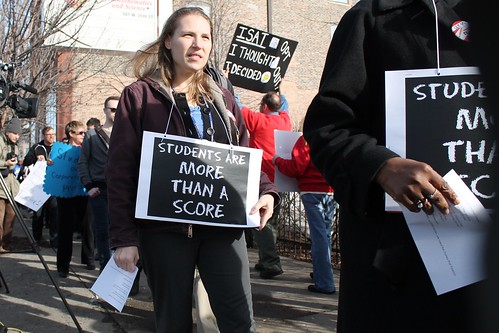 |
| Photo credit by BobboSphere on Flickr |
 Technology makes our lives easier! In particular at work. To be a teacher now on these days is less stressful and way more fun. Many teacher use electronic grading software as a virtual recordkeeping system (Maloy, pg 71). This program automatically calculates the overall grade without having to do some math. Isn't great? So, students can have immediate access to their grades, and allow them to see their progress during the semester.
Technology makes our lives easier! In particular at work. To be a teacher now on these days is less stressful and way more fun. Many teacher use electronic grading software as a virtual recordkeeping system (Maloy, pg 71). This program automatically calculates the overall grade without having to do some math. Isn't great? So, students can have immediate access to their grades, and allow them to see their progress during the semester.Using technology in lesson planning is the most effective way to get the students' attention. The internet provides vast electronic resources for supporting lesson development using students learning objectives and understanding by design approaches (Maloy, pg 65). Also, using videos or pictures are a big attention gather for students. I love to see pictures as a examples. I learn more visually than hearing.
In conclusion, chapter 4 discusses the student learning objective, the use of technology to make lesson plans, how teachers evaluate their students, etc. Designing lesson plans with technology makes it better.
Resources:
De La Garza, D. (2015, March 27). Untitled Banner. Retrieved March 27, 2015, from https://magic.piktochart.com/output/5254946-untitled-banner
Maloy, R., O'Loughlin, R., Edwards, S., & Woolf, B. (2013). Transforming Learning with New Technologies. 2nd Edition. Boston, MA: Pearson Education Inc.
(n.d.). Retrieved March 27, 2015, from http://www.brighthubeducation.com/student-assessment-tools/16137-the-pros-and-cons-of-standardized-testing/
Sheffer, S. (2014, February 18). Do ACT and SAT scores really matter? New study says they shouldn’t. Retrieved January 28, 2015, from http://www.pbs.org/newshour/rundown/nail-biting-standardized-testing-may-miss-mark-college-students/
There have been so many negative consequences in the past decade with the emphasis on standardized test scores. Unfortunately, it ended being counter-productive when it became the sole focus for not only student performance, but also teacher and school performance. Rather than use the assessment tool to focus on the student needs for learning, it became political and both students and teachers got caught up in the middle.
ReplyDelete